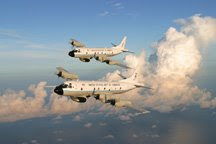
Here we go. Down the runway and into the air from MacDill AFB in Tampa, FL. The flight we are taking is our last into Hurricane Ike on Friday last (12 September), and it will last almost nine hours, bringing us back to this same base around 1:30 a.m. on Saturday morning. As we takeoff from sun-swept Tampa, we are high on anticipation and apprehension of what we will face when we arrive at the storm just offshore of Galveston Island, TX.
Our Flight Director is up to the challenge, and wearing his "lucky

hat he settles in for the long mission ahead. His job will be to safely direct us in and out of the storm as requested by the two PIs we have onboard. During this mission we will make seven penetrations into Ike's eye before heading back to our home base.
As we head for the storm which is about to make landfall, we note that tropical storm force winds (>34 kts.) were observed some 250 n.mi. east of the center of Hurricane Ike and that hurricane force winds (>64 kts.) extended out some 80 n.mi. at the surface. If you've never seen what the ocean looks like at low hurricane wind speeds, take a look at the

picture to the left taken en route to the storm.
As mentioned in earlier postings, the profile data obtained from our GPS dropsonde is vital to unlocking the secrets of any storm. This device, which is dropped from the aircraft, transmits temperature, pressure, humidity data back to the plane twice a second as it falls through the atmosphere to the surface. Because it has a full GPS receiver aboard, it also sends back very accurate information concerning the location of the sonde as it falls, to the

surface, and from this we can calculate very accurate wind speed and direction. These data have proven invaluable to the forecasters and modelers in developing better storm forecasts. The technician at the right is preparing a sonde for launch into the storm.
Penetrating the eye is always the most interesting part of the flight. You are always apprehensive on the first pass into the eye as to how rough the ride will be. Sometimes the pass through the eyewall can be a bone-jarring, teeth-rattling experience, but on other occasions it can be relatively smooth. If you were looking for an "E-ticket" (remember the old Disney World ride categories) ride into a hurricane, Ike, in its latter days, was anything but. The seven penetrations we made on this flight were more like "B-ticket" rides, which for those of us who do this as a living is great. Some of the VIPs and media who flew

with us on the last few flights into Ike felt otherwise.
Here's a visual image of what it looks like on the flight deck of a NOAA P-3 during a penetration into Ike. The flight engineer, who occupies the seat between the two pilots, is adjusting the power levers (throttles) to help maintain controlled flight. You can see the radar image on the scope in the center of the picture. As you can tell from the second image, it does get a bit bouncy as you hit the outer part of the eyewall.

Sometimes when you are in the center of the storm you observe other aircraft who are in the eye at the same time. The Air Force Reserves from Keesler AFB in Biloxi, MS are responsible for the routine hurricane reconnaissance flights, and we occasionally cross paths in the eye. Never fear. We maintain at least 2,000 ft.

from each other as well as keep in touch by radio at all times. The "spot" in the image to the left is one of the C-130Js that fly these storms.
Well, that's about it. To conclude this posting I want to share with you a few more images

from this flight. To the left is the Houston, TX radar image captured aboard the P-3 (Yes, we do have internet courtesy of

satellite communications) during the flight. To the right is the flight track of the P-3 during the mission, and in the center is the "master" hard at work.



1 comment:
Really fascinating stuff. Thanks for sharing. You are making me covet, which really isn't what Baptist preachers are supposed to do! Thanks for all you do. I hope the rest of the season is far less eventful.
Post a Comment